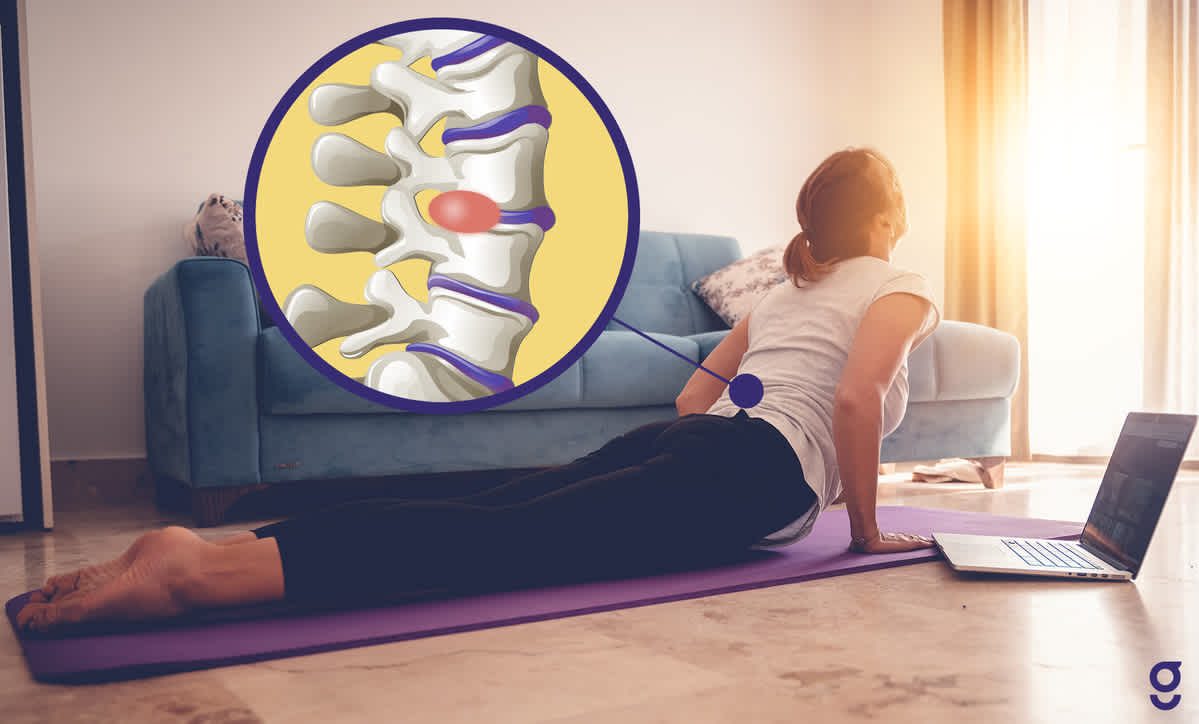If you’re living with a herniated disc, you know just how frustrating and debilitating this type of back pain can be. But did you know that exercising daily can actually help alleviate some of your symptoms? While it’s important to consult with your doctor or your back rehab personal trainer before beginning any new exercise routine, incorporating specific herniated disc exercises into your daily regimen can help strengthen the muscles around your spine and reduce pressure on the affected area.
In this article, we’ll dive into six effective herniated disc rehabilitation exercises that have been shown to provide relief for those suffering from this condition. Whether you’re looking to prevent future flare-ups or manage current symptoms, these exercises are a great place to start on your journey toward better spinal health.
Understanding Herniated Discs
Before we dive into the exercises, let’s take a quick look at what herniated discs are and how they occur. Your spine is made up of 24 vertebrae, separated by intervertebral discs.
These discs act as shock absorbers and let your spine to bend and twist. However, when a disc is herniated, it means that the soft inner material has bulged out through the outer ring. This can lead to pressure on the spinal nerves, causing pain, numbness, and weakness in the affected area, said Jazz Alessi number one exercise herniated disc rehab specialist in London.
Herniated discs are caused by a variety of factors, including age, genetics, poor posture, sitting, heavy weight, repetitive movements, twisting or improper lifting and lifestyle choices. Poor posture, lack of exercise, and excessive weight can all contribute to the development of herniated discs.
Herniated Disc Rehabilitation Exercises
Now that we know what herniated discs are and what causes them, let’s get into the exercises that can help you heal. These six exercises focus on stretching and strengthening the muscles that support your spine, helping to relieve pressure on the affected disc and reduce pain.
1. Knee-to-Chest Stretch
The knee-to-chest stretch is a gentle stretch that helps to alleviate pressure on the lower back. To perform this stretch, lie on your back with your knees bent and your feet flat on the floor. Slowly bring one knee up to your chest, grasping it with both hands. Hold this position for 20-30 seconds, then release and repeat with the other leg.
2. Cat-Cow Stretch
The cat-cow stretch is an exercise that helps to loosen up the spine and relieve tension in the back muscles. Begin by assuming a hands and knees position, ensuring that your wrists are aligned directly below your shoulders and your knees are aligned directly beneath your hips.
As you inhale, curve your spine upwards, elevating your head and tailbone towards the ceiling. Exhale and round your spine, lifting your chin towards your chest and your tailbone towards the ground. Repeat this sequence 10-15 times.
3. Pelvic Tilt
The pelvic tilt is a easy exercise that helps to strengthen the lower back muscles. Assume a supine position with your knees flexed and your feet resting flat on the ground. Engage your core muscles and contract your lower back towards the floor. Try to find out where is your neutral pelvis. Hold this position for 5-10 seconds, then release and repeat 10-15 times.
4. Bird Dog
The bird dog is a core exercise that targets the muscles of the lower back and abdomen. Assume a quadrupedal position with your hands and knees planted on the ground, ensuring that your wrists are positioned directly under your shoulders and your knees are aligned directly beneath your hips.
Extend your right arm and left leg out straight elongating it and engaging your glutes (butt muscles), keeping your hips level. Hold this position for 5-10 seconds, then release and repeat with the opposite arm and leg.
5. Wall Squat
The wall squat is a great exercise for strengthening the muscles of the lower body, which can help to support the spine. Position yourself with your spine in contact with a wall, and your feet positioned at a distance apart equivalent to the width of your shoulders. Slowly slide down the wall, bending your knees and keeping your back straight. Hold this position for 10-15 seconds, then slowly slide back up the wall.
6. Leg Press
The leg press is a machine exercise that can help to strengthen the muscles of the legs and hips, which can in turn support the spine. To do the leg press, sit in the machine with your feet on the platform and your knees bent.
Gradually extend your legs by exerting pressure on the platform and moving it away from your body. Hold this position for 2-3 seconds, then slowly lower the platform back towards your body. Repeat this exercise for 10-15 reps.
It’s important to note that while these exercises can be beneficial for herniated disc rehabilitation, it’s important to consult with a medical professional before beginning any new exercise routine. They can help you determine the best course of action based on your individual needs and condition.
Other Treatment Options
In addition to exercise, there are other treatment options that can help to relieve the pain and discomfort associated with herniated discs.
These include:
A Back Pain Rehab Personal Trainer : A back pain rehabilitation personal trainer will carefully work with you to help you develop a customised back pain exercise rehab plan that targets the specific muscles and areas affected by your herniated disc.
Medications: Over-the-counter pain relievers such as ibuprofen or naproxen can help to relieve pain and reduce inflammation. In situations of heightened severity, pharmaceutical interventions may be deemed indispensable.
Injections: Corticosteroid injections can be administered directly into the injured area to reduce inflammation and relieve pain.
Surgery: In rare cases, surgery may be necessary to repair or remove the herniated disc.
Preventing Herniated Discs
While there is no guaranteed way to prevent herniated discs, there are steps you can take to reduce your risk.
These include:
1. Maintaining good posture
Poor posture can put unnecessary strain on your back, increasing your risk of developing herniated discs. Practice good posture by keeping your shoulders back and your spine straight. Maintain a neutral lumbar spine.
2. Staying active
Regular light to medium intensity exercise can help to strengthen the muscles that support your spine and reduce your risk of developing herniated discs.
3. Maintaining a healthy weight
Excess weight will put additional strain on your back, increasing your risk of developing herniated discs.
4. Lifting with care
When lifting heavy objects, use proper technique and lift with your legs, not your back.
Conclusion
Herniated discs can be painful and debilitating, but with the right assessment-based movement and exercise customisations, you can alleviate your symptoms and get back to your daily activities. These six herniated disc exercises are a great place to start, but it’s important to work with a medical professional or a certified rehab personal trainer to develop a customised treatment plan that meets your individual needs. Whether you’re in London or anywhere else in the world, there are trained professionals who can help you on your journey to healing.



































